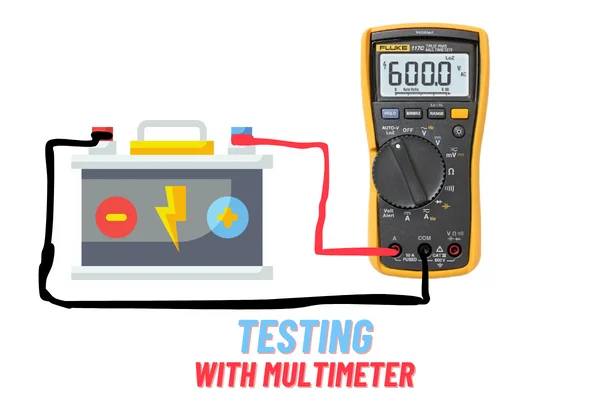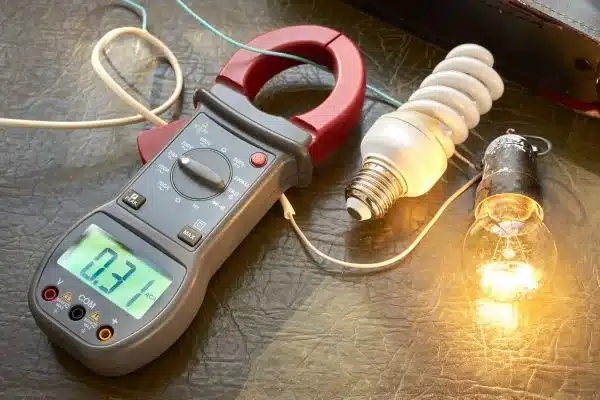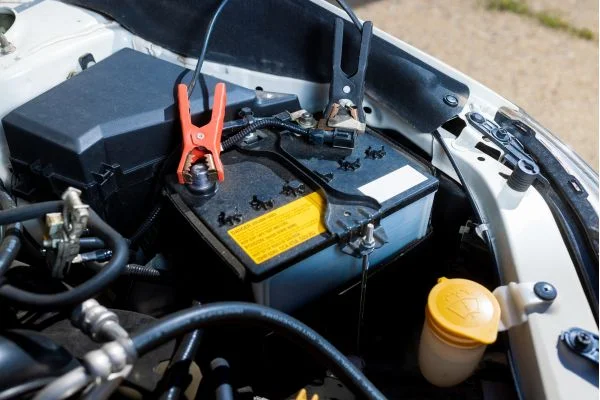Almost every portable device today is powered by a battery, and batteries come in all shapes and sizes. But how do you know if a battery is running low on power? As an electrician you must know how to check battery amps with a multimeter.
If you want to check how to test AGM battery with multimeter, I’ve written blog on it!
From your car to your phone, batteries are an essential part of our lives. One way to check is by testing the battery amps. So here we will look in to how to check battery amps with a multimeter.
Types of Batteries:
Batteries have different types of chemistries, which are used for different purposes. The most common type of battery is the lead-acid battery, which is used in cars and trucks. Lithium-ion batteries are also common, and these are used in portable devices like laptops and cell phones.
If you’re an automotive technician then you need a professional multimeter. To this hustle easier I have made a list of 8 best automotive multimeters for you.
Which is better lead acid battery or lithium battery?

There’s no simple answer to this question. It depends on the application. Lead-acid batteries are typically cheaper and have a shorter life span, while lithium-ion batteries are more expensive but have a longer life span. You can also use a battery tester for battery testing. I have also made a list of best battery testers for both beginners and professionals.
Tools Required to test battery amps:
To test battery amps, you only need a few essential tools.
- Clamp meter / Multimeter
- Tool Kit
How to Check Battery Amps With a Multimeter | Method 1
Now You know which tool suits you the most. So, let’s started step by step guide.
Step by Step Guide:
“This method is viable only to test battery like AA, AAA or abtteries having current below 10 Amps.”
- First of all, take a multimeter and set it to the “DC Amps” mode.
- Now, take the black lead and touch it to the negative (-) terminal of the battery.
- After that, take the red lead and attach it to the load as shown in below pic.


- Always make sure that you insert the black test lead in (com) and positive lead in the Amp (A) jack.
- Now you can see the results on the digital display. Make sure that you connect the battery in series with the multimeter. Otherwise, the meter will not show the results.
How to Check Battery Amps With Clamp meter | Method 2
To check battery amps with a clamp meter, follow the steps given below.
Select the Correct Clamp Meter: Ensure you have a clamp meter capable of measuring DC (direct current) amps. Make sure it’s appropriately rated for the expected current range.
Safety Precautions: Before working with electrical components, wear gloves and safety glasses.
Set Up the Clamp Meter: Select DC amp measurement mode on the clamp meter. To get an accurate reading, set the range to a higher value than the expected current.

Open the Clamp and Position: Place the meter’s clamp jaws around the wire carrying the current. It is important that the clamp encircles the wire completely without touching any other conductors. Consider measuring the current flowing through a battery cable for a car.
Read more about Best DC Clamp Meter for Automotive

Read the Display: You can read the measured current by looking at the clamp meter’s display. Check that you are reading DC amps. You might see 20.0 A on the display A with a straight line above it..
Interpret the Reading: Using the clamp meter, you can measure how much current flows through the wire. In our example, the car battery cable is carrying a current of 20.0 amps.
Record and Analyze: For future reference, write down or record the measurement. An unusually low or high measured current may indicate a circuit problem, such as an excessive drain or an open circuit.
Safety Guide:
Now you know how to check battery amps with a multimeter as well as clamp meter. But always keep in mind the following safety points while working with batteries.
- Never touch the battery terminals with your bare hands.
- Always wear safety goggles while working with batteries.
- Never work alone when dealing with batteries.
- Keep children and pets away from the work area.
- Disconnect the battery from the power source before starting any repairs.
- Never smoke while working with batteries.
- Follow the manufacturer’s instructions carefully.
- Be aware of the hazards of working with batteries.
What to do if your battery amps are low:
Now you know how to test car battery amps with multimeter. However, if your battery amps are low, there are a few things you can do to improve the situation.
- Check the battery terminals and clean them if necessary.
- Check the connections and make sure they are tight.
- Make sure the battery is properly charged.
- If the battery is damaged, replace it with a new one.
- Follow the manufacturer’s instructions carefully.
Battery amp myths busted!
Now that you know how to check battery amps, let’s bust some myths about batteries and amps.
- Nothing lasts forever. Even the best batteries will eventually need to be replaced.
- Batteries don’t like extreme temperatures. both cold and heat can damage batteries.
- Every Battery needs to be maintained regularly. This includes cleaning the terminals and checking the fluid level if applicable.
- All kinds of Batteries can be dangerous. Always follow the manufacturer’s instructions and take safety precautions.
- Most of the Batteries are expensive. While this is true, the cost of replacement batteries is often cheaper than the cost of repairing or replacing the equipment they power.
Why Check Battery Amps With a Multimeter?
Checking battery amps using a multimeter is a crucial practice for anyone dealing with electrical systems, whether professionally or as a hobbyist. Understanding the ampere rating of a battery helps ensure safety, efficiency, and longevity of electrical devices and systems. This article explores why checking battery amps with a multimeter is important and how to do it effectively.

Importance of Checking Battery Amps
1. Safety Considerations
Electrical systems operate within specified ampere ratings to prevent overheating and potential hazards such as short circuits or fires. Batteries that exceed their rated amps can pose significant safety risks. By using a multimeter to check amps, you can ensure that batteries are operating within safe limits, thereby reducing the risk of accidents.
2. Performance Evaluation
The ampere rating of a battery directly impacts its performance. Batteries that are underperforming in terms of amp output may not provide adequate power to devices or systems, leading to operational inefficiencies or failures. Checking battery amps allows you to assess whether a battery is delivering the expected current, ensuring optimal performance of connected equipment.
3. Battery Health Assessment
Over time, batteries can degrade or develop faults that affect their ampere output. Regularly measuring amps with a multimeter helps in monitoring the health of batteries. Significant deviations from expected ampere ratings may indicate internal damage or wear, prompting timely replacement or maintenance to prevent further issues.
How Multimeters Measure Battery Amps

1. Selection of Multimeter Setting
Most multimeters have a dedicated setting for measuring amps (current). Before measuring battery amps, ensure the multimeter is set to the appropriate current range. Failure to select the correct range can damage the multimeter or provide inaccurate readings.
2. Connection Procedure
To measure amps, the multimeter must be inserted into the circuit in series. This involves breaking the circuit and connecting the multimeter in line with the current flow. For safety and accuracy, follow manufacturer instructions and ensure proper insulation and secure connections.
3. Interpreting Multimeter Readings
Once connected, the multimeter displays the current flowing through the circuit in amperes. Compare this reading to the battery’s rated ampere capacity or expected output. Significant deviations may indicate issues such as internal resistance, partial cell failure, or the need for recharging.
Practical Applications of Ampere Measurement
1. Automotive Maintenance
In automotive systems, batteries power essential components such as starters and ignition systems. Checking battery amps helps mechanics diagnose electrical issues, such as insufficient cranking amps that may cause starting problems. It also aids in verifying the health of the battery charging system.
2. Renewable Energy Systems
In solar or wind energy installations, batteries store excess energy for later use. Monitoring battery amps ensures efficient energy storage and distribution. Deviations in amp readings can signal the need for battery maintenance or replacement to maintain system reliability.
3. Consumer Electronics
Portable devices rely on batteries to deliver consistent power. Measuring amps helps determine battery life and performance. For example, smartphones or laptops experiencing rapid power drain may benefit from checking amps to identify if the battery is the source of the issue.
Conclusion
There are multiple ways to test a battery but the most accurate way is to check battery amps with a multimeter. This guide provides you with all the information you need to know about how to check battery amps with a multimeter. So, follow the steps given above carefully and always take safety precautions while working with batteries.
FAQs about battery amps testing:
1. How often should I check my battery amps?
It is a good idea to check your battery amps every few months to ensure they are at optimal levels.
2. What is a normal battery amp reading?
A normal battery amp reading will vary depending on the type of battery. You can check the battery nameplate for more specific information.
3. What is a bad battery amp reading?
A bad battery amp reading is anything that is significantly lower than the normal battery amp reading. This could indicate a problem with the battery and it should be checked by a professional.







